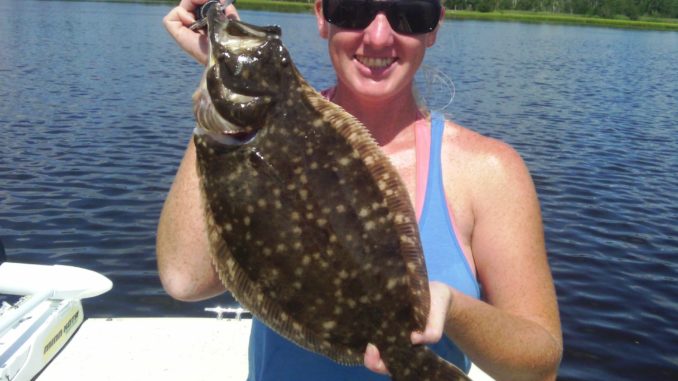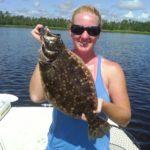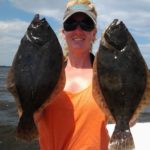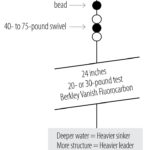
A Carolina Beach woman has flounder pinpointed for summer trips in the lower Cape Fear River; here’s what she looks for….
When Amanda King arrived in Wilmington a while back to attend college, she knew the Cape Fear coast was a special place and that she would probably be staying. She wound up working at the N.C. Aquarium at Fort Fisher running their surf-fishing seminars and similar projects, and doubling as a fishing guide who specializes in leading ladies and kids on trips exploring the Cape Fear River downstream from Wilmington to Southport from her Carolina Beach home.
That means, in June, she puts on her flounder-fishing cap as owner of Second Wind Charters and looks for fish up and down the river and adjacent marshes as they move in from the ocean and set up shop for the summer.
It was one such morning last year when King eased her boat up next to a current eddy that trailed off the downriver point of a small cove, slipping the anchor over quietly and positioning the boat to fish the lighter current running from the edge of the eddy to the bank of the cove.
“We’re a little early on the tide to get where I want to go, so I headed over to check out this little cove,” King said. “This is one of the first places the tide pushes bait through, and flounder and a few redfish often move in to eat when the tide first starts rising.”
King slipped a squirming mud minnow onto the hook of a Carolina rig and cast it near riprap at the cove’s point. She baited another rig and cast it closer to the boat, barely across the rip into the slower-moving water there. As she was slipping a soft-plastic lure on a jighead to fan-cast the area, the first rod dipped sharply and bounced back up.
“Watch that rod,” she said. “I’m hoping it’s a flounder. A flounder will grab a bait and then just sit there on the bottom turning it to swallow.”
King instructs fishermen to give flounder a little time after they pick up a bait before setting the hook because a flounder has to swallow a minnow head-first or the fins will jam in its throat. Using soft plastics, the hook can be set as soon as the fisherman feels a strike.
When the tide got right, King moved from spot to spot to fish small creek mouths, spoil islands lining the river channel and oyster beds. She stopped at the mouth of one creek that opened up into a cove behind an island.
“I’m easing into here to avoid spooking anything,” King said. “It’s shallow enough you can easily see the bottom and this water isn’t clear. Sound travels really well in water and in water this shallow fish are spooky.
“The tide is moving bait through here and there should be something feeding. There are oysters from the grass out about 10 feet, so cast just beyond them to keep from getting hung up. The flounder should be laying right on the edge of the oysters, and reds and trout will be swimming along them. As the tide rises, they’ll move up on the oysters closer to the grass, but it’s not deep enough yet.
The first cast produced a puppy drum, which brought a smile to her face.
“Redfish and flounder often feed together, and I’m sure there are flounder here,” she said. “It might take moving a time or two to find them, but they’re in here somewhere.”
A couple of undersized trout bit before she landed the first flounder, one barely a keeper that she released. She moved the boat a little and pointed to a clump of oysters still breaking the water’s surface, with directions to cast just short of them. The frisky mud minnow had been in the new location less than a minute when a visible thump resonated up her rod.
King thought it was a flounder, and she relaxed to let the flounder turn the mud minnow into position to swallow it. The pause seemed like forever, but King said it was only a slow 10-count before she eased in the slack line and leaned back to set the hook. The rod pulsed downward and the fish ran a little to the left. It rolled in the shallow water, and the tip of a flounder tail broke the surface.
A minute or two later, King led the flounder to the boat, where it was swept up in the landing net — a nice keeper.
Casting back at the oysters, several more flatfish decided to sample her offerings. King said there was a small ledge a few feet out from the oyster rock, and the current pushed bait along it. The flounder gather there to eat, and when a bait lands close enough to get their attention, there is a strike. When the oyster rock disappeared under the rising water, the bite slowed significantly.
King moved a couple of more times as the tide continued to rise. The catch continued to be mixed, but flounder became the majority.
At one point, King passed out spinning outfits rigged with a variety of soft plastic baits to fan-cast around an area, retrieving them slowly and twitching them off the bottom occasionally. At one spot, she located flounder about 30 feet off the bank.
King uses the shallow-draft Carolina Skiff to ease into the pockets and small bays around the edges of the river and between the spoil Islands created from sand and rock dredged from the ship channel. There is no doubt that the river’s strong currents move a lot of baitfish along these islands, and larger predators, especially flounder, move in to feed.
King is on the river every chance she gets and, as she showed this trip, has an excellent feel for when and where the baitfish buffets are set up.
DESTINATION INFORMATION
HOW TO GET THERE — Carolina Beach is east of Wilmington, just south of Wrightsville Beach. Best access is from I-40 and US 421. Public boat ramps are at Carolina Beach and Fort Fisher, and there is a fee ramp at Carolina Beach State Park where Snows Cut carries the ICW to the Cape Fear River.
WHEN TO GO — Flounder are in the bays, marshes and creeks of the lower Cape Fear River from late spring through late fall. Red drum and black drum will often be in the same waters.
BEST TECHNIQUES — Medium-light to medium-action spinning or baitcasting tackle is perfect, spooled with 10- to 15-pound mono or braid. Carolina rigs are standard for flounder fishing with live bait, including mud minnows, small menhaden and mullet minnows. A 3/4-ounce egg sinker above a barrel swivel and a 24-inch leader of 20- to 30-pound fluorocarbon typically ends in a 2/0 to 4/0 circle hook. Soft-plastic artificials also work fished on jigheads tied to short, 20-pound fluorocarbon leaders.
FISHING INFO/GUIDES — Amanda King, Second Wind Fishing Charters, 910-550-6324, www.secondwindfishing.com; Island Tackle and Hardware, 910-458-3049, www.islandtackleandhardware.com; Tex’s Tackle, 910-791-1763, www.texstackle.com. See also Guides and Charters in Classifieds.
ACCOMMODATIONS — MainStay Suites, Wilmington, 910-392-1741, www.mainstaywilmingtonnc.com; Sleep Inn, Wilmington, 910-313-6665, www.sleepinwilmingtonnc.com; Pleasure Island Chamber of Commerce, 910-458-8434, www.pleasureislandnc.org.
MAPS — Capt. Segull’s Nautical Charts, 888-473-4855, www.captainsegullcharts.com; Sealake Fishing Guides, 800-411-0185, www.thegoodspots.com; GMCO’s Chartbook of North Carolina, 888-420-6277, www.gmcomaps.com.







